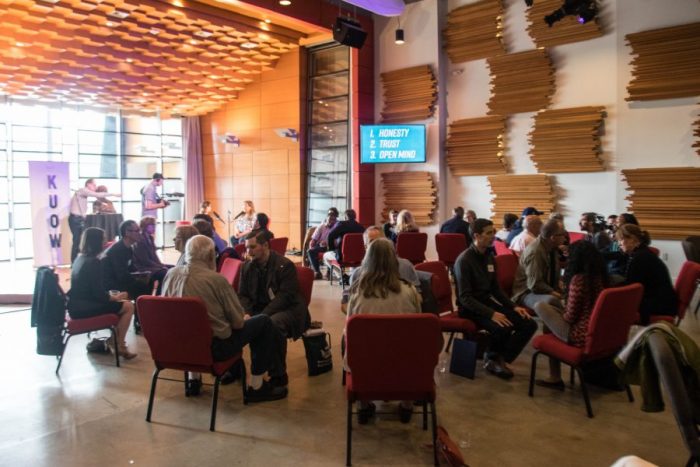
When’s the last time you actually talked with someone who was different from you, rather than talked about them?
The social fabric of the U.S. has been, in the understatement of the decade, significantly strained over the past few years. People retreated to their social tribes and groups of people they felt comfortable with, repeating ideas and ideologies and similar life experiences. Exhibit A was the U.S.’s 2016 presidential election: This disconnect between social groups (or certain camps of voters or partisan news consumers) contributed to news organizations’ perceived distance from actual voters.
Some media organizations see their role, in the process of deepening audience engagement overall, as being that bridge across the disconnect. Events are becoming a larger priority of outlets’ business teams, but the act of bringing varying people face to face (or Facebook to Facebook) has become a greater focus for a few. Spaceship Media’s Facebook groups have attempted to unite voters across the spectrum to discuss campaign issues; Whereby.Us’s Evergrey site in Seattle day-tripped with readers from the liberal-leaning metro area to farmer territory across the Oregon border; and KUOW’s Ask A series, another Evergreen State example, spotlights people of different characteristics and organizes a sort of speed-empathizing round robin session.
But do any of these work? These are truly nice gestures, but do these formats result in participants actually broadening their opinion or just digging in their confirmation bias? How do you measure things like this?A new paper studying KUOW’s process suggests that yes, it actually does. Written by University of Washington communication professor Valeria Manusov, recent UW PhD graduate and KUOW contract research analyst Daniel Stofleth, and KUOW’s executive producer of community engagement Ross Reynolds, the paper, published in the Howard Journal of Communications, reviews the short- and long-term outcomes of KUOW’s Ask A initiative.
KUOW’s Ask A project started in 2016, pitched to the community as “a series of person to person conversational events…It’s for people who are curious about groups in society they don’t interact with often, interact with negatively, or not at all — groups that are misunderstood or are getting negative attention in our heated political atmosphere.” (The discussion focuses included Muslims, Trump supporters, immigrants, transgender people, police officers, gun owners, foster parents, journalists, and more.) The researchers explained the events’ process:
This project brings together community members, half of whom are in a group highlighted in a particular session (e.g., members of the police, immigrants), for in-person round-robin discussions where people have the opportunity to ask members of the group about their group and about themselves. The present study is an assessment of the program, involving 11 different “out groups”…
The “askers” (those not in the highlighted group) talk face-to-face with each of those from the group (the “answerers”) for approximately 8 minutes in a neutral community setting. At the end of each exchange, the asker moves to the next answerer, until each of the answerers has talked with each of the askers.
This particular study focused on data from events in 2017 and 2018. (Events this year have ranged from private, very specific groups, like parents of autistic children asking autistic adults questions, to asking a judge about interpreting the law and keeping order in the court. Unclear if they let you bang the gavel.) The researchers surveyed 113 participants (there’s obviously some selection bias at play since it’s people who opted to attend in the first place) before, immediately after, and three months after the events took place, about whether the discussions changed their minds in a way that lasted. Some of their top findings:
People came in with the most negative attitudes/least empathy for Trump supporters and gun owners, and the most positive attitudes/most empathy for Special Olympians. It’s in Seattle, remember — only 8 percent of voters chose Trump compared to 87 percent who went for Clinton in 2016. In the survey immediately after the event, participants still had the most negative attitudes toward Trump supporters and gun owners, and felt most positively about Special Olympians, foster parents, and immigrants.
As positive attitudes increased, people’s nervousness about interacting with a particular group decreased. The researchers asked questions with answers on a seven-point scale like “How well do you know the group you’ll be speaking with?”, “To what extent, if any, are you nervous about the conversation you’ll have?”, and “How well do you now know…?”
Calm, collected dialogue helps foster a better attitude. The hypothesis that “people interacting with others in a civil discussion about the others’ group will increase in their positive attitudes toward that group immediately and over time” was confirmed. They also determined that people’s knowledge about a group increased immediately and over time.
Participants’ empathy for a different group after interacting with members from that group rose over time as well. “Most importantly, all of these means rose significantly as assessed right after the session, suggesting that the round-robin interaction process (and the related activities) worked effectively and as hypothesized,” the researchers wrote.
This corresponds with the findings of another study last year, which analyzed 25 newsrooms’ engagement initiatives (including KUOW’s Ask A) through the Center for Media Engagement. “Creating circumstances where people have positive interactions with outgroup members is key,” the researchers wrote then. They also included steps for how others could host these kinds of gatherings, such as encouraging a receptive mindset, involving people who are fair representatives of the group you’re trying to improve access of, and balancing the quantity and quality so that enough participants have enough time to actually make a difference.Broadening horizons can actually work. The question of how this broadening reflects back on KUOW as a news organization was not addressed in this paper, but its findings show that at least someone can do it.